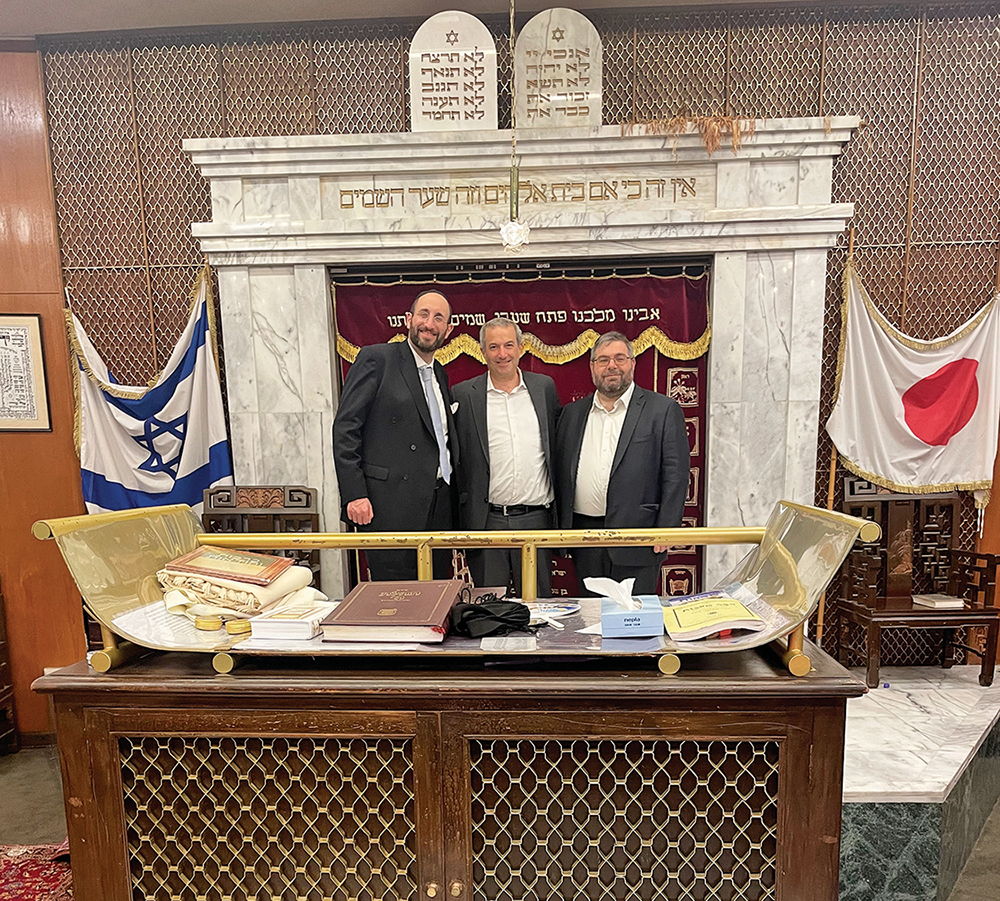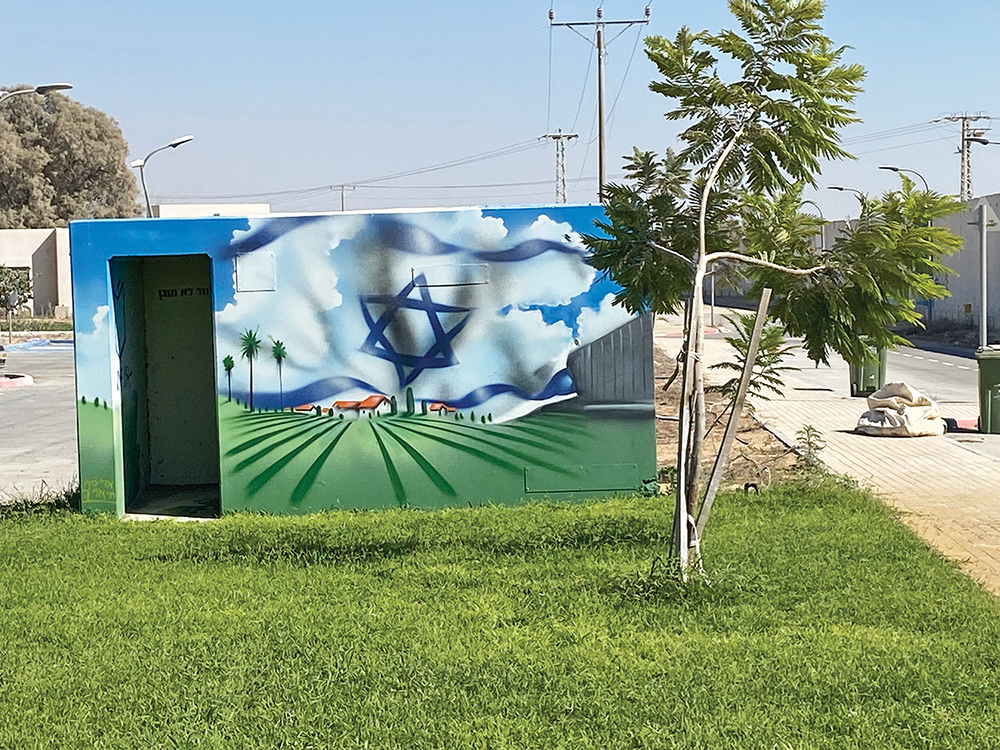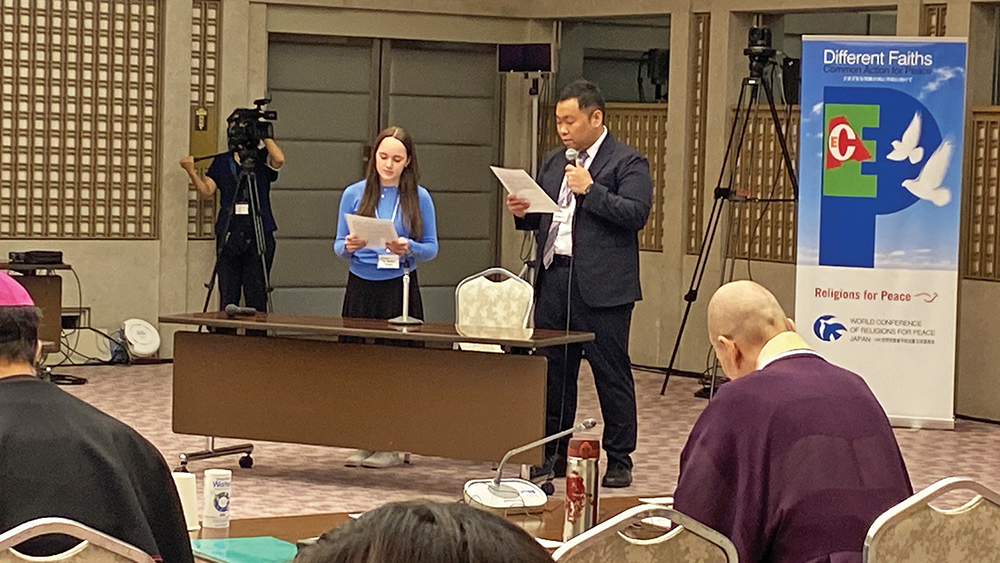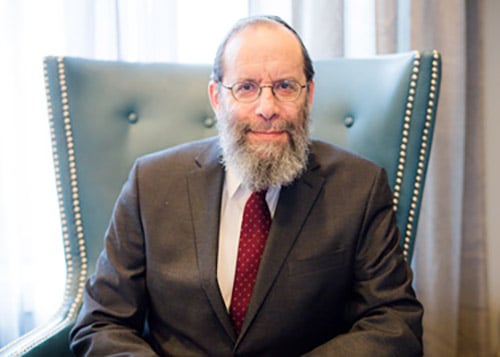
This summer I learned about peace from a country at war, and about war from a country at peace. My summer began with a trip to Japan and headed to a close with a trip to Israel.
In Israel, I joined a mission, together with my colleagues Rabbi Daniel Fridman and Rabbi Elliot Schrier, that focused on the aptly named Kerem Shalom, with which our Teaneck community is partnering and seeking to support. The extraordinary members of that kibbutz are dedicated to building and spreading peace, despite the enormous suffering inflicted upon them on Simchat Torah of last year. On that day, the heroic Amichai Weitzen and Yedidya Raziel lost their lives fighting for their community, and Amichai Schindler lost one arm and several fingers holding down the door of his house’s safe room, saving the lives of his wife and their six children.
Through all this, the Kerem Shalom community perseveres, a shining model of religious and secular coexistence. We were privileged to participate in the ceremony of the dedication of their new vineyard, and made a siyum on Seder Kodshim on the spot where the kedoshim gave their lives, and recited the words Hadran Alakh, Kodshim; we will return to you and what you represent.
In the background, with Gaza just over the fence, we could hear the deafening sound of exploding missiles every few minutes. Each time, the Americans jumped and the Israelis stood calmly. Behind them was a magnificent mural depicting the fence with the breach torn into it that morning; however, emanating from the gap was a glorious Israeli flag overlooking an image of a rebuilt community.

War is even more terrifying in the age of artificial intelligence. Technology brings the power to heal and also to destroy; perhaps no population knows this more than the Japanese, who felt the destructive power of the atom bomb 79 years ago, on August 6 and August 9, 1945. It was in that shadow that Japan hosted the “AI Ethics for Peace” conference in July, where representatives of major religions from all over the world gathered. I attended the conference as part of a delegation led by Yeshiva University President Rabbi Dr. Ari Berman.
The medium was quite literally the message: The conference was located in Hiroshima, the city destroyed by a devastating tool of then cutting-edge technology. In the decades since, Hiroshima has been rebuilt as a thriving monument to peace. The symbolism is clear: The world must commit to restrain its use of technology, ensuring that nothing like that ever happens again.
This issue was addressed with appropriate urgency and impressive unity, and the conference was inspiring and spoke to the needs of the moment. I was honored to be present. Yet, one is left to wonder if there are equally important messages that the location contained, also demanding expression.
A visit to the nearby Peace Memorial Museum, which effectively depicts the awful suffering the bombing caused, could leave one with the impression that this event was the result of barely explicable, inhuman aggression. A display attributed only two explanations to America’s decision, neither connected to any actions on the part of Japan: curbing the influence of the Soviet Union, and justifying the expense of the bomb’s production.
As an American—but more so as a student and teacher of ethics and history—the implication that Hiroshima’s bombing was an unwarranted and unjustified attack by a heartless superpower left me deeply unsettled. Ironically, this is the conclusion a computer could come to. A human perspective might be different: Perhaps the legacy of Hiroshima is actually the possibility of a just warrior to resoundingly defeat a brutal enemy, and to refute a militaristic ideology, leaving renunciation of hostility the only option, and allowing a peaceful, flourishing society to rise in the aftermath.
The undeniable violence of the attack masked the humanity of those who chose to launch it. The decision to drop the bomb was made by U.S. Secretary of War Henry Stimson, who worried, no less than the conference’s organizers, that “man’s technical capacity to do evil will outrun man’s human capacity to do good.” This concern was shared by U.S. President Harry S. Truman: “I fear that machines are ahead of morals by some centuries.”
Stimson’s thought process is conveyed in vivid detail in Evan Thomas’ book “Road to Surrender,” together with those of two other principals in this heart-wrenching, complex historical chapter, General Carl “Tooey” Spatz, who supervised the planes that dropped the bombs; and Japanese Foreign Minister Shigenori Togo, who worked to convince his government to surrender, when the cultural reality meant that that word could not even be uttered.
Thomas guides his readers through the process, impact and aftermath—short-term and long-term—and why, in his analysis, not only was the bomb on Hiroshima necessary, but the second one on Nagasaki was as well. Among other considerations, there was the belief that the Japanese were ready to commit national suicide for the Emperor, and, more rationally, that inflicting massive losses on the Allies could mean more favorable terms for Japan, even in defeat.
None of this was inarguable: The very choice of Hiroshima and Nagasaki may have reflected a misanalysis of their military/civilian balance; while the sparing of Kyoto, earlier designated a target, was the result of Stimson’s advocacy (against Harry Truman and others) not to “cut out the cultural heart of Japan,” Spatz’s diaries show that he agonized over “the brutal means … to a just end,” and went from opposing using the bomb to recommending dropping a third one, on Tokyo. A year after the bombing, a full issue of The New Yorker shocked Americans with the gruesome details of the effects, and Stimson was moved to make his case to the country, despite his own ongoing struggle with aspects of it, including his self-doubt as to whether he had adequately tried to get Japan to surrender before.

Thomas dismisses this doubt, deciding conclusively that Japan would not have surrendered, and moreover that the bombing not only saved the lives of countless American soldiers, but also of hundreds of thousands of Japanese who would have died in the continuing conflict and blockade, as well of other Asians in China and the Southeast who were being killed at the rate of 250,000 a month by the Japanese occupation. It was only after Nagasaki and the Soviet declaration of war on August 7 that Togo convinced a majority of the Japanese War Council to end the war. Thomas also rebuts the claim that challenging Russia was a significant factor in the decision. He further explains why “precision bombing” of military targets was not feasible, as well as the added persuasiveness of the second bomb—the Japanese had convinced themselves that no nation could have produced more than one.
Most to the point, Thomas concludes his account of the “decent, imperfect people who made the decision to use a frighteningly powerful new weapon” by writing that “Stimson, Spaatz, and Togo gave mightily of themselves to bring peace, and at last they succeeded.”
Will all of this agonizing, soul-searching and moral analysis be done by AI in the future?
In the current moment, it is the State of Israel that is at the forefront of preserving the humanity in this process, caught between enemies with no regard whatsoever for human life, and critics with no appreciation for the realities of war. Rabbinic tradition teaches that the biblical Jacob approached warfare with two equal fears: that he would die, and that he would be forced to kill others. His descendants continue to strive for the balance of both considerations.
There are other ways of analyzing the decision to drop the bomb, as well, that pose different challenges to non-human analysis. Walter Russell Mead, in his “The Arc of a Covenant,” ties American thinking at that time to Jacksonian philosophy, by which Japanese behavior at Pearl Harbor and in the treatment of war prisoners was dishonorable, and had to be countered with extreme force. “For Jacksonian America, the most logical and appropriate response to a terrorist attack is a massive response that breaks the will and the ability of the enemy to resume hostilities. While one should try to avoid civilian casualties if possible, the original aggressor bears all the guilt for all the deaths.”
By this logic, Mead notes, Jacksonian America supports Israel’s positions, and yet Israel itself functions from a more objective morality. Accordingly, “Israel’s actual policies are often more restrained than Jacksonians would like, and its military is far more concerned about legality than the average American Jacksonian would be in a similar situation, nevertheless Israel’s clear determination to defend its people and its military resonates deeply with Jacksonian ideas about how a country should defend itself.” Thus, in his formulation, America’s war with Japan and Israel’s war with Hamas have a common core, yet diverge. Which position would AI understand?
And yet, it should not be surprising that the perspective in Japan is absent of any of these justifications. At the International Military Tribunal trial in Tokyo following World War II, even an American defense advocate, Ben Bruce Blakeney, compared Hiroshima to Pearl Harbor, claiming to “speak for America … for democratic views of justice, of fair play … for the proposition that observing legal forms, while ignoring the essence of legal principles, is the supreme atrocity against the law.” Such thinking was dominant for Indian Justice Radhabinod Pal, who dissented from the majority and excused the Japanese military leaders from any liability for war crimes.
This attitude reflects an ethical and legal formalism; rules must be applied equally to all. No space here is allowed for the multifaceted, subjective variables that have nonetheless emerged compelling to so many. A computer might agree; humans, meanwhile, remain unpredictable.
My 13-year old daughter, Shaindel, as the youngest present at the “AI Ethics for Peace” conference in Japan, was tasked with publicly reading the resolution, which quoted from the plaque on the cenotaph, the Hiroshima War Memorial: “We shall not repeat the evil.” What is the intended reference: the evil action of America? Could it mean something more reflective of the whole picture? When the participants walked to the memorial itself, the original Japanese text was translated to us as “We will not repeat our mistakes.” A trusted friend told me the rendering should be “We shall not repeat the evils of war.” At the other extreme of how it appeared to me, the phrase is recorded in Gary J. Bass’ “Judgment at Tokyo” as “We shall not repeat the error,” in which Justice Pal is described as reading it and fuming at the “dodge of American responsibility” reflected in the “nonjudgmental inscription.”
Perhaps the ambiguity is tolerable, if the ends are accomplished. Even if the Peace Memorial Museum presents an incomplete picture, the suffering of the victims is undeniable and a crucial lesson for all on any side of military conflict. Another rabbinic tradition teaches that even necessary aggression should only be applied by those who appreciate the cost of the decision. Moses smashed the Tablets when he saw the Israelites worshiping the Golden Calf; he is told by God that he did the right thing, and yet that he must personally fashion the new set of Tablets, to appreciate the cost of what he broke.
In 2016, Barack Obama became the first sitting U.S. president to visit Hiroshima. In his remarks, he did not apologize for the bombing, nor criticize Truman, although some of his language that questioned the decision and appeared to equate both sides in the conflict could be open to interpretation. In this, he certainly invited disagreement.
Other aspects of his speech, however, should not be controversial. “We stand here, in the middle of this city, and force ourselves to imagine the moment the bomb fell. We force ourselves to feel the dread of children confused by what they see. We remember all the innocents killed … Those who died—they are like us.” He recognized that pain and loss are not a contradiction to acting harshly when necessary; it is, instead, a necessary complement. Will artificial intelligence allow for both parts of the process, doing what needs to be done and feeling its cost?
Ultimately, the question of America’s justification is beside the point, if we cannot guarantee that—and of course we cannot—the possessor of the next terrible weapon subscribes to the same standard, or if—perhaps worse—he mistakenly thinks that he does. If aggression can be prevented at the outset—if that can indeed be the legacy of Hiroshima—that is vastly preferable. Here, too, it is human beings who must bear witness, and internalize the emotional impact, so that painful history can not only teach but not have to repeat itself.
Their perception of the past aside, the Japanese people of today deserve enormous credit for their decision to harness their history as a lesson for a peaceful future, and to establish modern Hiroshima in that spirit. This was expressed by Emperor Hirohito himself, who, it was later disclosed, wished to convey publicly his remorse and regret for the war. He was prevented from doing so by others in his circle. Of most importance, though, is what he communicated when he visited Hiroshima on the sixth anniversary of Pearl Harbor and conveyed his commitment to abandon the warring ways of the past. “We must construct a peaceful Japan, keeping this deep disaster deep in our memory.”
For Israel, and other societies dealing with the scourge of terrorism, pacifism is not an option. Decisions that prioritize the greater good and do what is necessary to defeat and deter evil will continue to weigh heavily and require careful analysis, perhaps assisted by AI but always informed by the traditions of humanity the Forefathers of Israel sought to teach to the world.
Like everyone at the conference, and like the prophet Isaiah, I too fervently pray for the day when weapons will be abolished and humans will no longer wage war. But until that is possible, we pray that at least the war that is waged will be just, and that it is waged by humans.
Rabbi Daniel Feldman is rabbi of Teaneck’s Congregation Ohr Sadyah.










